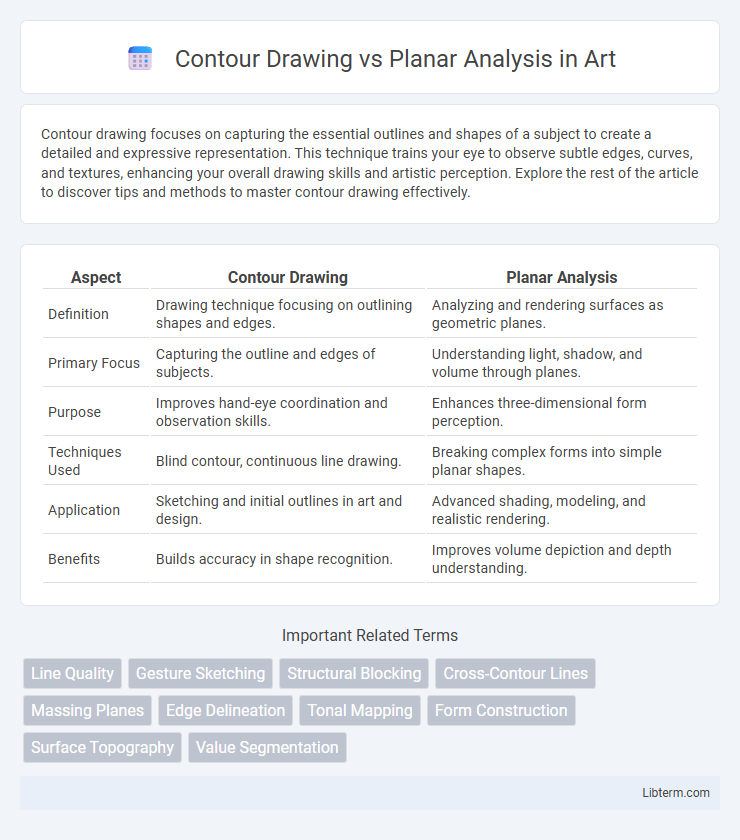Contour drawing focuses on capturing the essential outlines and shapes of a subject to create a detailed and expressive representation. This technique trains your eye to observe subtle edges, curves, and textures, enhancing your overall drawing skills and artistic perception. Explore the rest of the article to discover tips and methods to master contour drawing effectively.
Table of Comparison
| Aspect | Contour Drawing | Planar Analysis |
|---|---|---|
| Definition | Drawing technique focusing on outlining shapes and edges. | Analyzing and rendering surfaces as geometric planes. |
| Primary Focus | Capturing the outline and edges of subjects. | Understanding light, shadow, and volume through planes. |
| Purpose | Improves hand-eye coordination and observation skills. | Enhances three-dimensional form perception. |
| Techniques Used | Blind contour, continuous line drawing. | Breaking complex forms into simple planar shapes. |
| Application | Sketching and initial outlines in art and design. | Advanced shading, modeling, and realistic rendering. |
| Benefits | Builds accuracy in shape recognition. | Improves volume depiction and depth understanding. |
Introduction to Contour Drawing and Planar Analysis
Contour drawing emphasizes capturing the visible edges and outlines of a subject to define its shape and details accurately. Planar analysis breaks down complex forms into simplified, flat surfaces, helping artists understand light, shadow, and volume more effectively. Combining contour drawing with planar analysis enhances the ability to represent three-dimensional structures with precision and depth.
Defining Contour Drawing
Contour drawing emphasizes capturing the precise edges and outlines of a subject, focusing on the line quality and intricate details to represent shape and form. It prioritizes the continuous line that defines the boundary between different planes and surfaces. This technique enhances observational skills by training artists to see and replicate the actual contours without shading or perspective.
What is Planar Analysis?
Planar analysis is a drawing technique that breaks down complex three-dimensional forms into simplified, flat planes to better understand volume, light, and shadow. Unlike contour drawing which focuses on capturing the outline and edges, planar analysis emphasizes the structure beneath by representing surfaces as distinct geometric shapes. This approach enhances an artist's ability to depict form realistically and accurately by analyzing how planes interact and reflect light.
Visual Differences Between the Two Techniques
Contour drawing emphasizes capturing the continuous outline and intricate details of a subject, producing smooth, uninterrupted lines that define its shape and surface edges. In contrast, planar analysis breaks down the subject into distinct geometric planes, highlighting angular facets and shifts in surface orientation through intersecting planes and shading variations. Visually, contour drawings appear fluid and organic, while planar analysis results in a structured, faceted appearance that clarifies underlying forms and spatial relationships.
Materials and Tools Needed
Contour drawing primarily requires basic materials such as graphite pencils, fine-tip pens, and smooth drawing paper to emphasize line quality and detail. Planar analysis involves tools like charcoal, pastels, or soft graphite on toned or textured paper, facilitating the exploration of light, shadow, and surface planes. Both techniques benefit from an eraser and a ruler, but planar analysis often incorporates blending stumps or brushes to create smooth tonal transitions.
Core Principles of Contour Drawing
Contour drawing emphasizes capturing the precise edges and outlines of a subject, focusing on observing shapes to convey form and depth without shading. It relies on continuous line work to represent the visible boundaries, enhancing hand-eye coordination and spatial awareness. This technique contrasts with planar analysis, which breaks down subjects into flat planes to understand light, shadow, and volume more analytically.
Fundamentals of Planar Analysis
Planar analysis breaks down complex forms into simplified geometric planes to understand light, shadow, and structure effectively, emphasizing spatial relationships and volume over mere outlines. This method aids artists in capturing three-dimensionality by analyzing how flat surfaces interact with light sources, enhancing depth perception in drawings. Unlike contour drawing, which focuses on outlining edges, planar analysis prioritizes the study of angles, planes, and facets to build form accuracy.
Applications in Art and Design
Contour drawing emphasizes capturing the precise edges and outlines of subjects, making it ideal for detailed sketches and figure studies in art and design. Planar analysis breaks down complex forms into simplified geometric planes, aiding artists in understanding light, shadow, and volume for more accurate rendering and 3D modeling. Both techniques are essential in industrial design, animation, and fine arts to improve spatial awareness and enhance visual communication.
Advantages and Limitations of Each Method
Contour drawing enhances the observation of intricate details and fine edges, making it ideal for capturing shapes with precision; however, it can be time-consuming and less effective for representing volume or spatial depth. Planar analysis simplifies complex forms into geometric planes, improving the understanding of light, shadow, and three-dimensional structure, yet it may overlook subtle surface details and organic curves. Both methods complement each other by balancing detailed line work with structural comprehension, but artists must choose based on whether detail or dimensionality is the priority.
Choosing the Right Technique for Your Artwork
Contour drawing emphasizes capturing the precise outlines and edges of a subject to enhance detail and accuracy in artwork. Planar analysis breaks down complex forms into flat planes to understand light, shadow, and structure, aiding in creating depth and volume. Selecting the right technique depends on the artwork's goals: use contour drawing for detailed line work and planar analysis to develop realistic shading and three-dimensionality.
Contour Drawing Infographic

 libterm.com
libterm.com